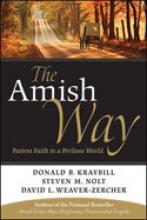On Oct. 2, 2006, the world was stunned by the killing of five Amish schoolgirls in a small schoolhouse in Nickel Mines, Pa. Within hours, the Amish community forgave the gunman and rallied around his family. It was an act of compassion and forgiveness so powerful, so unbelievable, and, for many, so questionable, that it led three authors who know the Amish well to write a book about the role of forgiveness in Amish culture: Amish Grace: How Forgiveness Transcended Tragedy.
Those three authors—Donald Kraybill, a senior fellow at the Young Center of Elizabethtown (Pa.) College; David Weaver-Zercher, professor of American religious history at Messiah College, Grantham, Pa.; and Goshen College history professor Steve Nolt—have released a new book, The Amish Way: Patient Faith in a Perilous World, from publisher Jossey-Bass. The first book ever about Amish spirituality and practice, it offers a rare inside look at how Amish Christian beliefs and practices inform every aspect of Amish daily life, and explains, for example, why they shun cars, have no electricity in their homes and stop formal education at Grade 8.
On some levels, the Amish and their countercultural ways offend the typical American’s individualist sensibilities, but this window into Amish religious beliefs may challenge—and even change—some of those perceptions. After all, the tight-knit Amish community fosters a genuine sense of belonging. Each day, these people choose to live out their core values of submission, obedience and patience, and to adhere to strict community rules, according to the authors.
The Amish Way is the story of the Amish religious experience, told through the Amish cultural lens by three scholars whom the Amish have come to trust as interpreters of their way of life. The authors explain how Amish faith is intertwined with community and commitment, child-rearing, home life, material possessions, the natural world, evil and sorrow.
Amish faith is engaging, mind-boggling at times and may prove problematic for some. But it may also serve as a challenge to people of faith, many of whom struggle daily to live out the tenets of their own faith in a world full of distractions. The book explores the complicated question: “Is there anything the Amish can teach the rest of us about living meaningfully in the modern world?”
In a review, Publishers Weekly writes, “Refreshingly, this study makes a point of focusing on the spiritual and theological aspects of their world, rather than simply cataloguing the outward cultural characteristics. Horse-drawn transportation and simple clothing do make their appearances, but they are revealed to be simply incidental to a deeply felt faith, rather than something to gawk at.”
See also the feature on Amish fiction: “Peeking under the bonnet.”




Add new comment
Canadian Mennonite invites comments and encourages constructive discussion about our content. Actual full names (first and last) are required. Comments are moderated and may be edited. They will not appear online until approved and will be posted during business hours. Some comments may be reproduced in print.